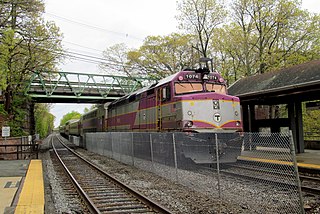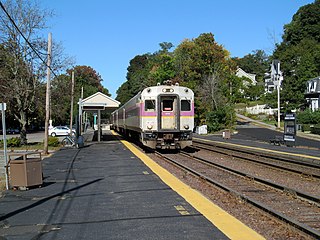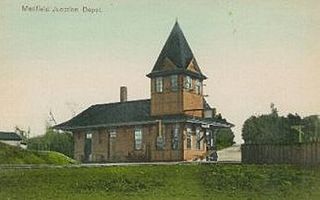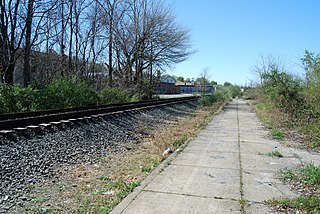
The Northeast Corridor (NEC) is an electrified railroad line in the Northeast megalopolis of the United States. Owned primarily by Amtrak, it runs from Boston through Providence, New Haven, New York City, Philadelphia, Wilmington, and Baltimore to Washington, D.C. The NEC closely parallels Interstate 95 for most of its length, and is the busiest passenger rail line in the United States both by ridership and by service frequency as of 2013. The NEC carries more than 2,200 trains daily.

The MBTA Commuter Rail system serves as the commuter rail arm of the Massachusetts Bay Transportation Authority's transportation coverage of Greater Boston in the United States. Trains run over 398 mi (641 km) of track to 141 different stations, with 58 stations on the north side and 83 stations on the south. It is operated under contract by Keolis, which took over operations on July 1, 2014, from the Massachusetts Bay Commuter Railroad Company (MBCR).

The Boston and Albany Railroad was a railroad connecting Boston, Massachusetts to Albany, New York, later becoming part of the New York Central Railroad system, Conrail, and CSX Transportation. The line is currently used by CSX for freight. Passenger service is still provided on the line by Amtrak, as part of their Lake Shore Limited service, and by the MBTA Commuter Rail system, which owns the section east of Worcester and operates it as its Framingham/Worcester Line.

The Boston University Bridge, originally the Cottage Farm Bridge and commonly referred to as the BU Bridge, is a steel truss through arch bridge with a suspended deck carrying Route 2 over the Charles River, connecting the Boston University campus to Cambridge, Massachusetts. According to the American Association of State Highway and Transportation Officials route log, the bridge also carries U.S. Route 3 across the river to its southern terminus at U.S. Route 20. However, the Massachusetts Department of Transportation does not consider the bridge to be a part of US 3; it continues the route along Memorial Drive in Cambridge until it meets Route 2A at the end of the Harvard Bridge.

The Grand Junction Railroad is an 8.55-mile (13.76 km) long railroad in the Boston, Massachusetts, area, connecting the railroads heading west and north from Boston. Most of it is still in use, carrying scrap either inbound or outbound to the Schnitzer scrap yard on the Everett waterfront or freight to the Chelsea Produce Market, and non-revenue transfers of Amtrak and MBTA passenger equipment between the lines terminating at North Station and South Station. The line is also notable for its railroad bridge over the Charles River that passes under the Boston University Bridge between Boston and Cambridge, Massachusetts.

The Fairmount Line or Dorchester Branch is a line of the MBTA Commuter Rail system in Boston, Massachusetts, USA. Except for a short portion in Milton, it lies entirely within Boston, running southwest from South Station through the neighborhoods of Dorchester, Mattapan and Hyde Park. Weekend service began on November 29, 2014. Most trains reverse direction at the south end at Readville, but some Franklin Line trains use the Fairmount Line rather than the Northeast Corridor. On October 21, 2019, some Fairmount Line trains were extended over the Franklin Line to Foxboro as part of the Foxboro Line.

The Central Massachusetts Railroad was a railroad in Massachusetts. The eastern terminus of the line was at North Cambridge Junction where it split off from the Middlesex Central Branch of the Boston and Lowell Railroad in North Cambridge and through which it had access to North Station in Boston. From there, the route ran 98.77 miles west through the modern-day towns of Belmont, Waltham, Weston, Wayland, Sudbury, Hudson, Bolton, Berlin, Clinton, West Boylston, Holden, Rutland, Oakham, Barre, New Braintree, Hardwick, Ware, Palmer, Belchertown, Amherst, and Hadley to its western terminal junction at N. O. Tower in Northampton with the Connecticut River Railroad.

The Framingham/Worcester Line of the MBTA Commuter Rail system runs west from Boston, Massachusetts to Worcester, Massachusetts through the MetroWest region, serving 17 station stops in Boston, Newton, Wellesley, Natick, Framingham, Ashland, Southborough, Westborough, Grafton, and Worcester. The third-longest and second-busiest line on the system, the Framingham/Worcester Line is plagued by poor track conditions, interference from freight trains, and a number of non-handicapped-accessible stations. Service on the line is a mix of local and express trains serving Worcester plus short-turn Framingham locals.
The Urban Ring was a proposed project of the Massachusetts Bay Transportation Authority and the Massachusetts Department of Transportation, to develop new public transportation routes that would provide improved circumferential connections among many existing transit lines that project radially from downtown Boston. The Urban Ring Corridor is located roughly one to two miles from downtown Boston, passing through the Massachusetts cities of Boston, Chelsea, Everett, Medford, Somerville, Cambridge, and Brookline. The project was expected to convert 41,500 car trips to transit trips daily.

Braintree station is an intermodal transit station in Braintree, Massachusetts. It serves the MBTA's Red Line and the MBTA Commuter Rail Old Colony Lines as well as MBTA buses.

The New England Central Railroad began operations in 1995. It is a subsidiary of Genesee & Wyoming and runs from New London, Connecticut, to Alburgh, Vermont at the Canada–US border, a distance of 366 miles (589 km). The railroad interchanges with the CN, CSX, MCER, PAS, P&W, GMRC, WACR, and VTR.

The Haverhill Line is a branch of the MBTA Commuter Rail system, running north from downtown Boston, Massachusetts through the cities and towns of Malden, Melrose, Wakefield, Reading, Wilmington, Andover, North Andover, Lawrence, and Haverhill.
The Fall River Subdivision is a freight railroad line in the U.S. state of Massachusetts, owned by the Massachusetts Bay Transportation Authority, with freight operations handled by the Massachusetts Coastal Railroad; it was formerly owned and operated by CSX Transportation. The line runs from the New Bedford Subdivision at Myricks south to Fall River along a former New York, New Haven and Hartford Railroad line. At its south end, at the Rhode Island state line in Fall River, it becomes a line of the Providence and Worcester Railroad.
The New Bedford Subdivision is a freight railroad line in the U.S. state of Massachusetts owned by the Massachusetts Bay Transit Authority, with freight operations handled by the Massachusetts Coastal Railroad. The line runs from the end of the CSX Middleboro Subdivision near Weir Village south to New Bedford along a former New York, New Haven and Hartford Railroad line. It junctions the Fall River Subdivision at Myricks.

Readville station is a Massachusetts Bay Transportation Authority (MBTA) commuter rail station located in the Readville section of the Hyde Park neighborhood of Boston, Massachusetts. It is served by MBTA Commuter Rail Fairmount Line and Franklin Line. Readville is the outer terminus for most Fairmount service, though some trips continue as Franklin Line trains. The station is located at a multi-level junction, with the Northeast Corridor tracks at ground level and the Dorchester Branch above; Franklin lines use a connecting track with a separate platform. Platforms are available for the Providence/Stoughton Line on the Northeast Corridor tracks, but they are not regularly used. An MBTA maintenance and storage yard and a CSX Transportation freight yard are located near the station.

South Coast Rail is a project to build a new southern line of the MBTA Commuter Rail system along several abandoned and freight-only rail lines. The line has been planned to restore passenger rail service between Boston and the towns of Taunton, Berkley, Fall River, Freetown, and New Bedford, on the south coast of Massachusetts. It would restore passenger service to some of the southern lines of the former Old Colony Railroad and the New York, New Haven and Hartford Railroad.

Medfield Junction is a railway junction and former train station located in northwest Medfield, Massachusetts. It is the junction of the Framingham Secondary and the former Millis Branch. The station was open from November 1861 until April 1967.

Fall River station is an under-construction MBTA Commuter Rail station in Fall River, Massachusetts. The station is being constructed as part of the South Coast Rail project and is expected to open in late 2023.

Beacon Park Yard was a CSX Transportation rail yard in Allston, Boston, now owned by Harvard University. The yard opened in 1890 on the site of a former trotting park, from which it took its name. It was closed in 2013 following the relocation of the yard's container operations to Worcester, Massachusetts and opening of a transload facility in Westborough, Massachusetts. Plans for the yard include relocation of the Massachusetts Turnpike Allston exit, construction of a new MBTA commuter rail station and layover yard, and a major real estate development.

Track 61 is an industrial rail terminal track in South Boston, Massachusetts, also known as the Boston Terminal Running Track. Track 61 is the last remnant of the vast rail yards that once covered much of the South Boston waterfront. Track 61 legally begins at Summer Street, while the line from Bay Junction to Summer Street is the Boston Terminal Running Track and Terminal Yard. However, the names are frequently used interchangeably.


















